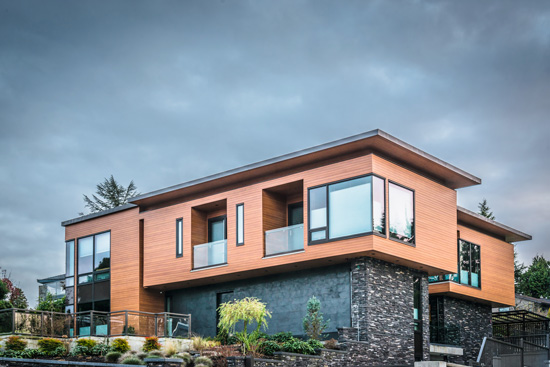Easing Minds and Boosting Facade Performance
WHY HUMANS LIKE WOOD
The wood-look exterior sends an overt message to the shopping public: we are different now; come in and see. But the use of wood also carries proven latent effects, say many experts in architecture, biophilia, and psychology. “Studies suggest that natural elements in built environments can restore energy and well-being,” according to Jim Guffey, principal of Kansas-based specialty wood rainscreen fabricator Wood Haven Inc., including those showing “their positive effect on the intelligence and cognition of school-age children, the health of the elderly, and generally reductions in stress and anger.”
Much of the research is rooted in the biophilia hypothesis, posited by Edward O. Wilson in his 1984 book Biophilia to describe humans’ “urge to affiliate with other forms of life.” In 2002, Wilson’s colleague and co-author Stephen R. Kellert, a social ecology professor at Yale, collaborated with University of Washington psychology expert Peter H. Kahn Jr. on the influential book Children and Nature. Drawing on various professional disciplines, the work reveals the evolutionary underpinnings of how nature affects childhood, and why a “weakened childhood experience of nature in modern society” has profound educational and political consequences.
With this in mind, a number of architects have incorporated more natural materials and figurative imagery into schools, university buildings, and cultural and civic facilities for end-users of all ages. Examples include the wood-paneled museums and music hall interiors by Snøhetta, the K-12 schools in Connecticut and Yale University laboratory designs by firm Svigals + Partners, and college residences by San Diego’s Carrier Johnson + CULTURE, such as the LEED Platinum complex at Pitzer College in Claremont, California. Wood finishes—and, in rare cases, engineered structural timber—are increasingly seen as features of prominent urban architecture, even including tall buildings. In these projects, frequently a wood-look product carries the theme in exterior and high-floor applications.

Photo courtesy of Chris Dikeakos Architects Inc. and Kohn Pedersen Fox Associates (KPF)
For the new Broadway and Pacific mixed-use tower in San Diego by the firm KPF and Chris Dikeakos Architects, a back-framed aluminum wall system comprises 6-inch-wide, V-groove aluminum panels in a light ash finish.
In San Diego, for example, the design for the new Broadway and Pacific mixed-use development by the firm KPF and Chris Dikeakos Architects, Inc. employs a back-framed aluminum wall system for a required high-performance architectural application. The signature skyscraper, which broke ground last year, is clad in 39,000 square feet of 6-inch-wide, V-groove aluminum panels and soffit material in a light ash finish. An integral, complete back-framing system provides for continuous insulation (CI) as well as structural connections to the building structure. “The product looks like real wood slats, and the selection of widths and application for both color and grain choices was very good, and the design for all the major soffits on the project called for ‘woodlike’ slats that are reminiscent of cedar or fir soffits,” says architect Mike Alivojvodic, AIBC, MRAIC, a principal at the firm. He adds that the materials were specified to achieve the look of a wood soffit material, while meeting the stringent state and local code requirements for fire ratings and wind suction loads.
For these large-scale buildings and high-rise applications, the use of wood provides a compelling and humanizing gesture for the city, as Safdie might say, yet it requires a building method compatible with typical curtain wall and panelized facade techniques. For the Broadway and Pacific project, the cladding employs a thermally broken aluminum T-clip and extruded aluminum sub-girts for attaching the woodgrained rainscreen cladding systems to the primary walls. The aluminum T-clips connect directly to the primary wall to match the framing dimensions or as needed to match typical CI products, or both. With a thermal break to prevent heat loss or gain, the T-clips project horizontally to clear the insulation depth and attach to sub-girts running vertically that carry the aluminum cladding by means of clips. Clip spacing varies, but typically they are attached using two screws, with a third screw attaching the sub-girt to each clip.
Following its testing of a similar system with a dead load of 1.5 pounds per square foot., Morrison Hershfield concluded that the wood-finished aluminum system is appropriately designed for noncombustible high-rise building envelopes. Thus, the wood-look skyscraper is not only possible, but it also offers a high-performance option for more architects to consider. The back-framing system can be used for any primary wall systems, including light-gauge steel, masonry, and concrete. The systems resist wind loads of up to 70 pounds per square foot, according to Morrison Hershfield’s engineers, and they also meet the prescriptive requirements of the energy code ASHRAE 90.1 – 2007/2010 for all climate zones when using continuous insulation.
“The finished aluminum products achieve this without having to worry about regular maintenance that is associated with real wood,” adds Alivojvodic, listing various reasons that the architects selected a relatively new entrant in the building products marketplace. “The back framing system is key to making the product work in this design as it provided for a clip-on installation without seeing gaps or surface-mounting elements like the other products considered.” Summarizing, Alivojvodic has said that “aside from the look being achieved, the product met fire regulations, it can be engineered to deal with wind loading issues, and the finished product allows for a flush installation without the need for surface attachments.”

Photo courtesy of Longboard – A division of Mayne Coatings Corp.
A house with stone and woodgrain siding can have positive effects on the occupants because the materials help connect people with nature and provide comfortable and productive places, say experts in biophilic design.









